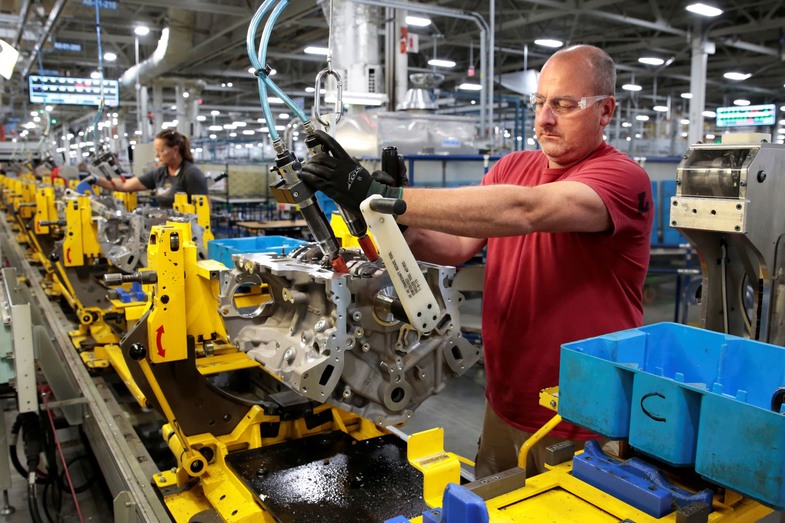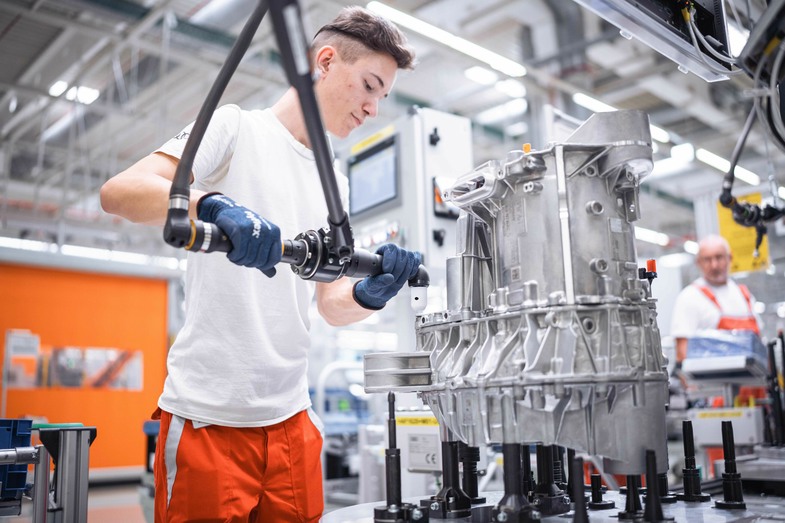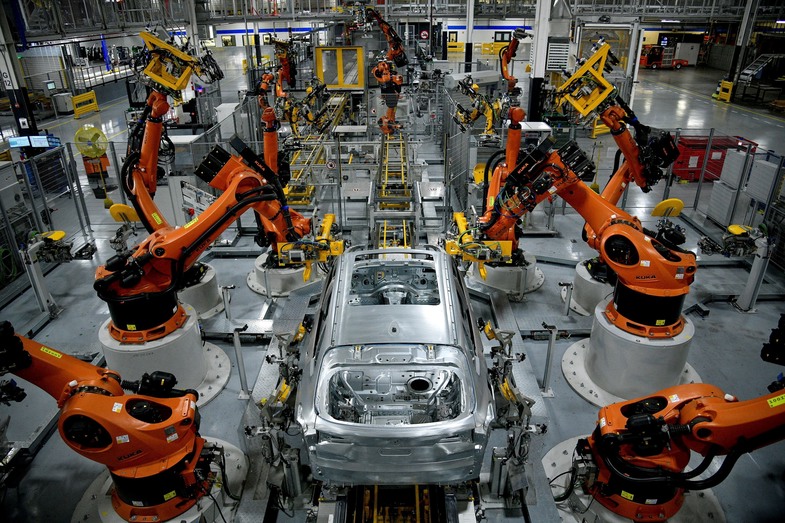Production, the intricate process of crafting goods and services to fulfill consumer demands, stands as the backbone of economic development and global trade. As a pivotal economic activity, production involves the meticulous conversion of raw materials, labor, and capital into the final products that sustain modern societies.
From its humble origins in the Stone Age to the contemporary era of smart factories and technological integration, production has undergone an evolutionary journey marked by innovation and efficiency.
In this content, we aim to examine the multifaceted dimensions of production, illuminating its importance in economic growth, its various types, its examples across industries, and the profound impact of technology on modern production processes.
Contents
What is Production?
Production refers to the process of creating goods and services to meet the needs and wants of consumers. It involves transforming inputs, such as raw materials, labor, and capital, into finished products or services that can be sold in the market. Production is a crucial economic activity that drives growth and development in an economy.
Production plays a crucial role in the global economy, making a significant contribution of trillions of dollars to international trade and providing employment opportunities for millions of individuals annually. Starting from its modest beginnings in the Stone Age, the production sector has undergone a remarkable transformation, progressing from primitive Neolithic tools to modern-day smart factories.
These advanced facilities are equipped with automated processes, constantly connected machinery, and data-driven production systems, establishing an industry that thrives on innovation and cutting-edge technology.

Importance of Production
Production plays a crucial role in any economy as it is the process of creating goods and services to satisfy the needs and wants of consumers. Without production, there would be a lack of resources and products necessary for everyday life. The importance of production can be seen in various aspects:
1) Economic Growth
Production is essential for economic growth as it creates employment opportunities and generates income for individuals and businesses. When there is an increase in production, it leads to higher levels of output, which contributes to the overall growth of an economy. Increased production also promotes innovation and technological advancements, leading to improved productivity and efficiency.
2) Meeting Consumer Demand
Production ensures that goods and services are available to meet the demands of consumers. When production levels are high, it helps in satisfying the needs and wants of individuals, improving their standard of living. By producing a variety of products, different consumer preferences can be catered to, thereby enhancing consumer satisfaction.
3) Wealth Creation
Production drives wealth creation in an economy. As goods and services are produced, they are sold in the market, generating revenue for businesses. This revenue can then be reinvested in expanding production capacity, research, development, and improving infrastructure – all of which contribute to overall economic growth.
4) International Trade
Production plays a critical role in international trade. Countries with a strong production base have a competitive advantage in the global market. By producing goods and services that are in demand worldwide, countries can export and earn foreign exchange. Export-oriented production can also lead to the growth of domestic industries, job creation, and economic stability.
5) Social Development
Production is not only vital for economic development but also for social development. Industries and businesses employ a workforce, providing stable jobs and income opportunities for individuals. This, in turn, leads to reduced poverty, increased social mobility, and improved living standards. Additionally, production fosters skill development and knowledge transfer, empowering individuals and communities.
6) Resource Management
Production helps in efficient resource management. By optimizing the use of resources such as labor, raw materials, and capital, production processes can reduce wastage and maximize output. Efficient production methods, such as lean manufacturing and just-in-time systems, help minimize costs and environmental impact.
In conclusion, production is of utmost importance to any economy. It drives economic growth, meets consumer demand, creates wealth, facilitates international trade, fosters social development, and optimizes resource management. A healthy and efficient production sector is essential for the overall development and prosperity of a nation.

Types of Production
There are various types of production processes that determine the way goods or services are produced. These types can be classified based on different criteria, such as the nature of the product, the technology used, or the level of automation. Some of the common types of production are:
- Job Production: Also known as tailor-made production, Job Production involves the creation of unique and customized products to meet specific customer requirements. This type of production is typically used for items with complex designs or when the quantity demanded is low. Examples include custom-made furniture, wedding dresses, or one-of-a-kind artworks.
- Batch Production: Batch production involves the production of goods in groups or batches. A certain quantity of the product is manufactured at one time before moving on to the next batch. This type of production allows for some customization while also benefiting from the advantages of mass production techniques. Examples include bakery products, pharmaceutical drugs, or clothing.
- Mass Production: Mass production is characterized by the large-scale production of standardized goods. Here, products are produced in bulk, usually using assembly-line techniques or automated machinery. This mode of production allows for high productivity, lower costs, and fast production rates. Examples include consumer electronics, automotive vehicles, and fast-food chains.
- Continuous Production: Continuous production is a type of production that operates round-the-clock with minimal interruptions. It involves the continuous and uninterrupted flow of products with high automation and integration of machinery. Industries such as oil refineries, chemical plants, or power generation plants adopt continuous production to ensure a steady supply of products.
- Process Production: Process production involves the production of goods that are indistinguishable from each other. These goods go through a continuous and uniform production process, resulting in standardized output. Examples include commodities like steel, cement, or paper, where the final products are nearly identical regardless of the source materials used.
- Intermittent Production: Intermittent production is characterized by periodic production activity interspersed with non-production periods. This type of production is typically used when demand for the product is highly irregular or seasonal. Examples include ice cream production during the summer season or the manufacturing of holiday decorations.
It’s important to note that these production types are not mutually exclusive and can be combined or adapted to suit specific industries or products. The choice of production method depends on factors such as market demand, product complexity, cost considerations, and the level of automation desired. By understanding these different types of production, businesses can effectively plan their operations and optimize their production processes.

Example of Production
Production is a process that involves transforming inputs into outputs, creating goods and services that are useful to society. There are various types of production processes depending on the nature of the output and the method used. Here are some examples of production in different industries:
- Manufacturing: One of the most common examples of production is manufacturing. This involves the production of tangible goods through various methods such as assembly lines, mass production, or custom production. For instance, a car manufacturing plant produces cars by assembling various parts like engines, chassis, and interiors.
- Agriculture: Agriculture is another sector where production takes place. Farmers cultivate crops, rear livestock, and produce agricultural products such as grains, fruits, vegetables, dairy products, and meat. This production process involves sowing seeds, nurturing crops, harvesting, and processing the agricultural products.
- Construction: Construction is an industry that involves the production of infrastructure and buildings. This can include residential homes, commercial buildings, bridges, roads, and dams. The production process in construction involves planning, designing, procurement of materials, and actual construction activities.
- Mining: Mining is the process of extracting valuable minerals and resources from the earth. It involves activities such as exploration, drilling, digging, and refining. Examples of mining production include the extraction of coal, gold, copper, diamonds, and oil.
- Services: Production is not limited to just physical goods. Services are also a form of production where the output is intangible. Examples of service production include healthcare services, transportation services, banking services, and education services. These industries provide valuable services to customers, contributing to their well-being and satisfaction.
- Software Development: In the digital age, software development has become a crucial industry. Companies produce software applications, websites, and mobile apps through coding, testing, and debugging processes. This type of production is essential for the advancement of technology and the digital economy.
- Entertainment: The entertainment industry involves the production of movies, TV shows, music, and other forms of entertainment. It includes stages like scriptwriting, filming, editing, and distribution. The output of this production process is enjoyed by audiences worldwide.
These are just a few examples of production across different industries. Production is a vital aspect of an economy as it drives economic growth, generates employment opportunities, and satisfies the needs and wants of individuals and organizations.
The 4 Factors of Production
In economics, production refers to the process of creating goods and services to satisfy the needs and wants of individuals and society as a whole. There are four basic factors of production in the production process. These are; land, labor, capital and entrepreneurship.
1) Land
Land, in the context of production, refers to all natural resources that are used to create goods and services. This includes physical resources such as land itself, as well as natural resources like minerals, water, and forests. Land provides the platform on which production activities take place, and it is an essential input in various industries such as agriculture, mining, and construction.
2) Labor
Labor refers to the physical and mental efforts exerted by individuals in the production process. It encompasses the work done by both skilled and unskilled workers. Labor is a crucial factor as it involves the skills, knowledge, and expertise of individuals in transforming raw materials into finished products or delivering services. The quantity and quality of the labor force greatly impact the efficiency and productivity of production.
3) Capital
Capital refers to all man-made resources that are used in production. It includes physical assets such as machinery, buildings, tools, equipment, and infrastructure. Capital plays a crucial role in enhancing productivity by facilitating the production process, reducing labor requirements, and improving the quality of goods and services. Capital is often acquired through investment and is a critical factor in economic growth and development.
4) Entrepreneurship
Entrepreneurship is the ability to bring together the other factors of production – land, labor, and capital – and allocate them effectively and efficiently to create goods and services. Entrepreneurs take risks, make business decisions, and organize resources to develop new products, processes, and ventures. Their role in driving innovation, creating employment opportunities, and driving economic growth is vital.
These four factors of production are interdependent. They are generally involved together in every production process. The availability and efficient utilization of these factors greatly influence the overall productivity, economic growth, and development of a nation.
It is worth noting that in addition to these four traditional factors, some economists include knowledge and technology as additional factors of production, highlighting their growing importance in the modern economy.

The Role of Technology in Production
Technology plays a crucial role in the production process, revolutionizing industries across the globe. Advancements in technology have significantly enhanced efficiency, productivity, and quality in various types of production. Here, we will explore how technology influences production and the benefits it brings.
Automation and Robotics
One of the most significant changes brought about by technology in production is the introduction of automation and robotics. Automation, through the use of computer-controlled machinery, has streamlined the manufacturing process, reducing the need for manual labor and minimizing human error. This has resulted in faster and more precise production, ultimately improving overall output.
Robots, on the other hand, have replaced humans in performing repetitive tasks that were previously time-consuming and labor-intensive. With their ability to work around the clock without fatigue, robots have revolutionized industries such as automotive, electronics, and food production.
Computer-Aided Design and Manufacturing (CAD/CAM)
Computer-Aided Design and Manufacturing, commonly known as CAD/CAM, has transformed the production landscape. CAD software enables designers to create and visualize products in a virtual environment, providing greater precision and design flexibility. This technology has greatly accelerated the product development process, reducing time-to-market for new products.
CAM software, on the other hand, facilitates the translation of design concepts into machine instructions. It allows manufacturers to automate the manufacturing process, such as programming CNC machines, thus improving accuracy, reducing waste, and increasing productivity.
Internet of Things (IoT)
The Internet of Things (IoT) is another game-changing technology that is reshaping production. By connecting various devices and systems through the internet, IoT enables real-time monitoring and control of production processes. This means that machines, sensors, and other equipment can communicate with each other, leading to increased efficiency and effectiveness.
With IoT, production managers have access to valuable data regarding machine performance, energy usage, and supply chain optimization. This data-driven approach allows for predictive maintenance, reduced downtime, and improved decision-making, ultimately optimizing production processes.
3D Printing
3D printing, also known as additive manufacturing, has emerged as a disruptive technology in production. It allows for the creation of physical objects from digital models by layering materials. This technology offers significant advantages, including increased design freedom, rapid prototyping, and reduced material waste.
Moreover, 3D printing has the potential to transform supply chains, as it enables decentralized production. Instead of relying on traditional manufacturing processes that involve transportation and storage, goods can be printed on-site, reducing lead times and logistics costs.
Virtual and Augmented Reality
Virtual and augmented reality (VR/AR) technologies are also making their mark in production. They provide immersive and interactive experiences, enhancing training, design, and assembly processes. VR/AR enables technicians to visualize complex equipment and machinery, aiding in maintenance, troubleshooting, and repairs.
Additionally, these technologies can facilitate collaborative design and prototyping, allowing teams to work together remotely, reducing the need for physical iterations, and improving efficiency.
In conclusion, technology has become integral to the production process, revolutionizing industries through automation, CAD/CAM, IoT, 3D printing, and VR/AR. These advancements have significantly improved efficiency, quality, and productivity, leading to faster time-to-market, reduced costs, and enhanced customer satisfaction. Embracing and leveraging technology in production is crucial for businesses to stay competitive in today’s fast-paced market.
Videos Related to Production
We would like to suggest you a video about production. You can learn about production by watching this video. You can click HERE for more videos.
